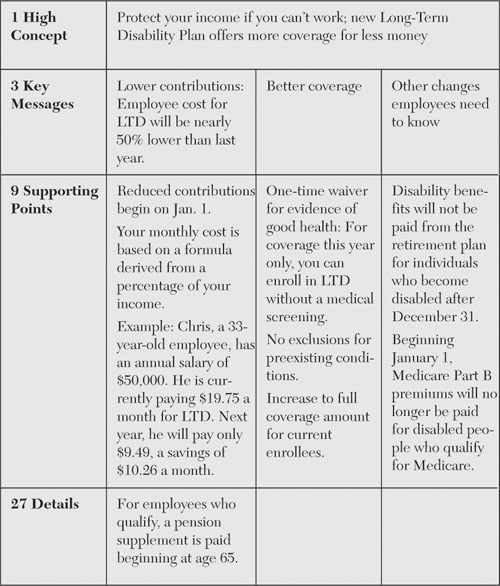4. Frame Your Message
You’ve just given a presentation to senior management about your new program. Your PowerPoint deck was appropriately detailed: 44 slides explaining why the program is needed, how you designed it, and what it contains. And your hard work paid off, because the meeting went well; management approved the program, giving you the go-ahead to implement it.
Now it’s time to communicate with employees. And here’s the first thing you should do: Close the PowerPoint file and take out a blank sheet of paper. Why? Because the way you structured your message to “sell” your program to management is very different from how you need to frame your message for your employee audience.
Again, why? As you saw in Chapter 2, “Treat Your Employees Like Customers,” it starts with demographics: Your employee audience has a different perspective than senior managers. And that difference means you need to rethink how you shape your key messages to meet the needs of your employee audience.
How the Communication Needs of Senior Managers and Employees Differ
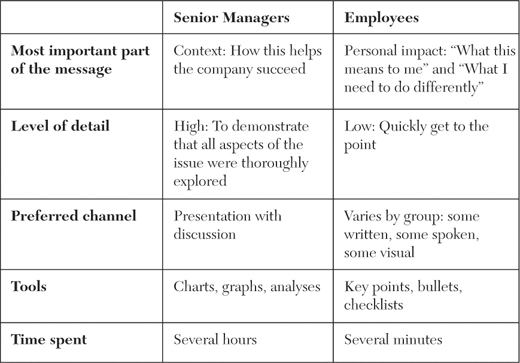
So how do you proceed? Here’s the essence: Refer to the objectives you created in Chapter 3, “Plan and Manage Communication.” With those objectives in mind, use that blank piece of paper to answer this question: What’s the most important thing employees need to know? As you write the answer, limit your response to 15 words or less.
Congratulations! You’ve just “framed” your message: You’ve created a core statement that captures the essence of what you need to communicate. You’ve also created the foundation for a message platform, which will help you organize all your communication about your new program.
This sounds good, but if this task is new to you, you may need some help. Stay with us; we show you three easy-to-use approaches to framing your message:
• “Go Hollywood” to create a high concept
• Use the inverted pyramid to organize your message
• Leverage the 3-9-27 formula to structure content
“Go Hollywood” to Create a High Concept
We know what you’re thinking: What does Hollywood have to do with HR communication? Well, as you’ve probably figured out by now, we believe in borrowing the best techniques from any field to make our communication more effective.
And, as it turns out, no one is better than Hollywood’s movie studios at distilling a product into just a few words and at making that message riveting to audiences around the world. Movie promoters have realized that they have just a few seconds to capture an audience’s attention as people walk by a movie poster or flip through TV channels. So movie people have figured out how to capture the essence of a film in a single, simple statement.
That statement, in movie talk, is called a “high concept.” The idea is that, in order to pitch (to a producer or the audience), you have to convey an entire two-hour movie in about 12 to 15 words. Once the movie gets the green light, the high concept is used as the basis of all marketing, including ads, posters, publicity, e-mails, and websites.
Going Up!
Here’s another term for “high concept”: an “elevator speech.” The idea is that you get into an elevator with a colleague who says something like, “Hey, I hear we’re changing the vacation policy. What’s up with that?” Your challenge is to answer the question in the time it takes to ride the elevator; that’s why it’s called an elevator speech.
By the way, the latest term for delivering information quickly and concisely is an “escalator speech.” The assumption is that you don’t even have as much time as it takes to ride the elevator: You have only about 20 seconds, or the length of time it takes to say about 140 characters (the standard length of a “tweet” on the social media platform Twitter or a status update on LinkedIn or Facebook).
And the Oscar Goes to . . .
Based on the following “high-concept” statements, name the Academy Award-winning movie:*
* Answers: a) Slumdog Millionaire, b) Rainman, c) Titanic, d) The Sound of Music
a. A teenager is one question away from winning India’s “Who Wants to Be a Millionaire.” But is he cheating?
b. A selfish man seeking his inheritance discovers his autistic savant brother, abducts him, and takes him on a cross-country road trip.
c. A rich girl and a poor boy meet on the ill-fated voyage of the “unsinkable” ship.
d. In 1930s Austria, a woman leaves a convent to become a governess to a Naval officer widower with seven children.
Here’s why we love the “high concept”: because you can use the technique to communicate anything—a new initiative, changes to a benefits program, a company strategy. The key is to boil down a complicated idea into its essence so that your audience can understand it instantly.
High-Concept Worksheet
Here’s an opportunity to practice your new knowledge of creating the high concept. We’ve completed the first one; it’s up to you to create a high concept for the others.
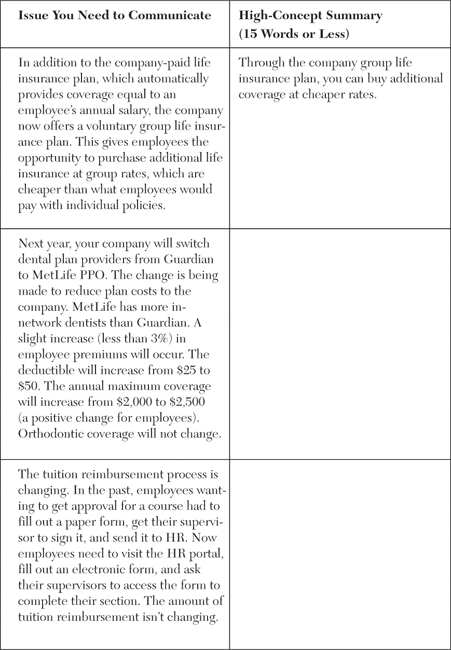
Use the Inverted Pyramid to Organize Your Message
Now that you’ve got the essence of your message, what do you do next? We suggest you turn back the clock to an antiquated form of communication—the telegram—for inspiration on how to organize your content.
Back in the 19th century, newspaper reporters relied on the telegram to send a breaking news item to their editors. The problem was that, especially in the early days, the telegram was unreliable; the lines were always going down for one reason or another, such as high winds or Indian attacks.
So reporters began structuring their messages with the most important news first, in descending order of importance to the end. That way, if only part of the telegram got through before the transmission was interrupted, the newspapers would still get the scoop.
Around this time, editors began to encourage all their reporters to use this structure, whether or not they had to use a telegraph. “Write 15 inches of copy on that story,” an editor would tell a reporter. The story would be typeset, and if the editor didn’t have room for the entire story, it would be easy to him to cut from the bottom to fit the space available.
This way of organizing information came to be known as the inverted pyramid. The top contains the most critical points, and the bottom contains details or optional information, as shown in Figure 4-1.
Figure 4-1 The inverted pyramid
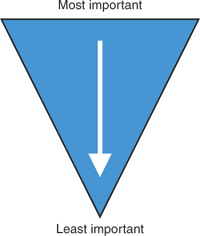
Way back in the day, when Jane was in journalism school, budding reporters learned another technique to help them create the first paragraph of the pyramid: five Ws and an H. She learned that the lead paragraph of a news story is the most that many readers will read or scan, so she was urged to make sure to convey the following elements to communicate the most important information:
• Who: The subject of your communication
• What: The action: what action will occur, what needs to happen
• When: The date the change will occur
• Where: The location(s)
• Why: The motivation behind or reason for the action
• How: The process and method of the action
Fast-forward to today’s fast-paced, information-overloaded world. You may be surprised to learn that the old-fashioned inverted pyramid is still the best format for much of the information you need to convey. Employees are too busy to sit and read content from start to finish; they want to skim and scan to get to the most relevant parts. So the inverted pyramid provides a quick, easy-to-digest way to get information.
Remember that the same principle you used to develop your high concept applies to the inverted pyramid: The information most important to employees comes first. As you travel down the pyramid, you can then add context and details.
“Am I Doing This Wrong?”
After Alison gave a presentation on best practices in communication at a regional HR conference in DeKalb, Illinois, she opened the floor to questions. A woman in the front row raised her hand.
“I’m an HR manager for a hospital,” she said by way of introduction. “You said that the most effective way to create a message is to put the most important, most relevant information up front.”
“That’s right,” said Alison.
“Early in my career, I was taught that you tell the story in chronological order. So when I send an e-mail to employees about a benefits change, for example, I start with why we decided to make a change and what options we explored. And then I write about what’s changing.” She paused. “Am I doing this wrong?”
Alison hesitated. She didn’t want to insult the HR manager, but she had to tell her the truth.
“Sorry, but yes, you are,” Alison said. “What employees need first is what’s changing and what the change means to them. They may want the background information eventually, but make sure it comes much further down in the message.”
Leverage the 1-3-9-27 Formula to Structure Content
Math may not have been your favorite subject in school, but when it comes to structuring complex content, a simple mathematical model can be your friend. That model is 1-3-9-27. This doesn’t stand for a multiplication equation; it represents a format you can use to organize even the most detailed communication.
Here’s what it looks like:
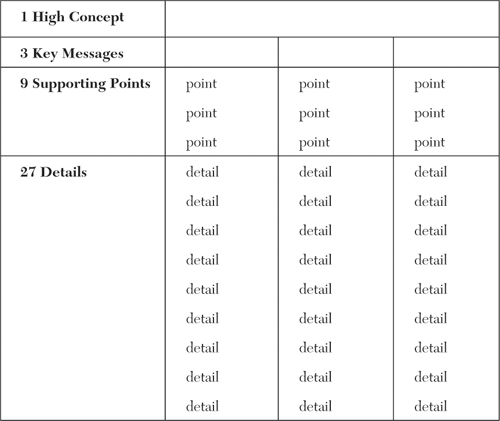
This principle is the same as the one used to organize a closet. When your content is arranged by category (shoes, handbags, dresses), it’s easier to store, view, and find when you need it. Especially when you’re dealing with detailed issues such as health and retirement plans, 1-3-9-27 puts everything in its place—which helps employees easily understand the content when you communicate.
Plus, 1-3-9-27 builds on the foundation we’ve described throughout this chapter: You start with your high concept, develop key messages (the same as you would for building an inverted pyramid), and then fill in the details.
Depending on the topic, you may not use all the elements of 1-3-9-27, but you know the structure is there if you need it.
Checklist for Framing Your Message
![]() Start with your objectives: What do you need employees to believe and do? That becomes the foundation of your message.
Start with your objectives: What do you need employees to believe and do? That becomes the foundation of your message.
![]() Put away the PowerPoint you used to present to senior management, and start with a clean sheet of paper. Remember that what matters most to leaders may be quite different from what employees want to learn.
Put away the PowerPoint you used to present to senior management, and start with a clean sheet of paper. Remember that what matters most to leaders may be quite different from what employees want to learn.
![]() Steal a technique from Hollywood and create a “high concept”: a single statement (of 15 words or less) that captures the key message you want to convey.
Steal a technique from Hollywood and create a “high concept”: a single statement (of 15 words or less) that captures the key message you want to convey.
![]() Create your content using an old-fashioned journalism framework called the inverted pyramid. Put the most important information first, and then arrange the remaining information in order of descending importance, down to the details.
Create your content using an old-fashioned journalism framework called the inverted pyramid. Put the most important information first, and then arrange the remaining information in order of descending importance, down to the details.
![]() Try the 1-3-9-27 method for organizing all your details, especially for more complicated communications.
Try the 1-3-9-27 method for organizing all your details, especially for more complicated communications.

